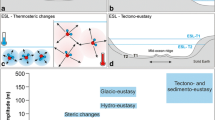Abstract
Optimal interpolation method is applied to Geosat altimetry data both to remove orbit error and to separate temporal mean sea surface dynamic topography (SSDT) from temporal fluctuations around the mean. Loss of long-wavelength oceanic signals at orbit error reduction procedure is smaller in this method than that in conventional collinear methods, but the areal average height over the study domain is still removed as the orbit error. The fluctuation SSDT is quantitatively evaluated by sea level data from tide gauge stations at Japanese islands. The correlation coefficient of the two sea-level variations is 0.83 when the loss of the areal average is compensated by the seasonal variation of the areal average height determined from the climatological monthly-mean SSDT. In addition, the improvement of the geoid model by combined use of Seasat altimetry data and hydrographic data is validated through the estimated temporal mean SSDT. In a local area where hydrographic data contemporary with the Seasat mission exist, the geoid model has been significantly improved so that the absolute SSDT can be determined from combination of the altimetry data and geoid model; the absolute SSDT describes the onset event of a quasi-stationary large meander of the Kuroshio south of Japan very well. Outside this local area, however, errors of several tens of centimeters still remain in the improved geoid model.
Similar content being viewed by others
References
Aoki, S., S. Imawaki and K. Ichikawa (1995): Baroclinic disturbances propagating westward in the Kuroshio Extension region as seen by a satellite altimeter and radiometers.J. Geophys. Res.,100(C1), 839–856.
Bretherton, F. P., R. E. Davis and C. B. Fandry (1976): A technique for objective analysis and design of oceanographic experiments applied to MODE-73.Deep Sea Res.,23, 559–582.
Cheney, R. E., J. G. Marsh and B. D. Beckley (1983): Global mesoscale variability from collinear tracks of Seasat altimeter data.J. Geophys. Res.,88(C7), 4343–4354.
Cheney, R. E., B. C. Douglas, R. W. Agreen, L. Miller, D. L. Porter and N. S. Doyle (1987):Geosat Altimeter Geophysical Data Record User Handbook. NOAA Tech. Memo. NOS NGS-46, U.S. Govt. Print. Office, Washington, D.C., 29 pp.
Cheney, R. E., B. C. Douglas and L. Miller (1989): Evaluation of Geosat altimeter data with application to tropical Pacific sea level variability.J. Geophys. Res.,94(C4), 4737–4747.
Ganeko, Y. (1983). A 10′×10′ detailed gravimetric geoid around Japan.Marine Geodesy,7, 291–314.
Glenn, S. M., D. L. Porter and A. R. Robinson (1991): A synthetic geoid validation of Geosat mesoscale dynamic topography in the Gulf Stream region.J. Geophys. Res.,96(C4), 7145–7166.
Haines, B. J., G. H. Born, G. W. Rosborough, J. G. Marsh and R. G. Williamson (1990): Precise orbit computation for the Geosat Exact Repeat Mission.J. Geophys. Res.,95(C3), 2871–2885.
Ichikawa, K. and S. Imawaki (1992): Fluctuation of sea surface dynamic topography southeast of Japan estimated from Seasat altimetry data.J. Oceanogr.,48, 155–177.
Ichikawa, K. and S. Imawaki (1994): Life history of a cyclonic ring detached from the Kuroshio Extension as seen by the Geosat altimeter.J. Geophys. Res.,99(C8), 15,953–15,966.
Ichikawa, K., S. Imawaki and H. Ishii (1995): Comparison of surface velocities determined from altimeter and drifting buoy data.J. Oceanogr.,51, 729–740.
Imawaki, S., K. Ichikawa and H. Nishigaki (1991): Mapping the mean sea surface elevation field from satellite altimetry data using optimal interpolation.Marine Geodesy,15, 31–46.
Koblinsky, C. J., P. Gaspar and G. Lagerloef (editors) (1992):The Future of Spaceborne Altimetry: Oceans and Climate Change. Joint Oceanographic Institutions Incorporated, Washington, D. C., 75 pp.
Lerch, F. J., J. G. Marsh, S. M. Klosko and R. G. Williamson (1982): Gravity model improvement for SEASAT.J. Geophys. Res.,87(C5), 3281–3296.
Mazzega, P. and S. Houry (1989): An experiment to invert Seasat altimetry for the Mediterranean and Black Sea mean surfaces.Geophys. J.,96, 259–272.
Mitchum, G. T. (1994): Comparison of TOPEX sea surface heights and tide gauge sea levels.J. Geophys. Res.,99(C12), 24,541–24,553.
Nerem, R. S., B. D. Tapley and C. K. Shum (1990): Determination of the ocean circulation using Geosat altimetry.J. Geophys. Res.,95(C3), 3163–3179.
Paik, H. J., J.-S. Leung, S. H. Morgan and J. Parker (1988): Global gravity survey by an orbiting gravity gradiometer.EOS Trans. Amer. Geophs. Union,69, 1601, 1610–1611.
Rapp, R. H. and Y. M. Wang (1994): Dynamic topography estimates using Geosat data and a gravimetric geoid in the Gulf Stream region.Geophys. J. Int.,117, 511–528.
Schlax, M. G. and D. B. Chelton (1994): Detecting aliased tidal errors in altimeter height measurements.J. Geophys. Res.,99(C6), 12603–12612.
Shibata, A. and Y. Kitamura (1990): Geosat sea level variability in the tropical Pacific in the period from November 1986 to February 1989, obtained by collinear method.Oceanogr. Mag.,40, 1–26.
Tai, C.-K. and W. B. White (1990): Eddy variability in the Kuroshio Extension as revealed by Geosat altimetry: Energy propagation away from the jet, Reynolds stress, and seasonal cycle.J. Phys. Oceanogr.,20, 1761–1777.
Tapley, B. D., G. H. Born and M. E. Parke (1982): The SEASAT altimeter data and its accuracy assessment.J. Geophys. Res.,87(C5), 3179–3188.
Teague, W. J., M. J. Carron and P. J. Hogan (1990): A comparison between the generalized digital environmental model and Levitus climatologies.J. Geophys. Res.,95(C5), 7167–7183.
Thiébaux, H. J. and M. A. Pedder (1987):Spatial Objective Analysis: With Applications in Atmospheric Science. Academic Press, London, 299 pp.
Wagner, C. A. and C. K. Tai (1994): Degradation of ocean signals in satellite altimetry due to orbit error removal processes.J. Geophys. Res.,99(C8), 16255–16267.
Wunsch, C. (1986): Calibrating an altimeter: How many tide gauges is enough?J. Atmos. Ocean. Tech.,3, 746–754.
Wunsch, C. and V. Zlotnicki (1984): The accuracy of altimetric surfaces.Geophys. J. Roy. Astron. Soc.,78, 795–808.
Author information
Authors and Affiliations
Rights and permissions
About this article
Cite this article
Ichikawa, K., Imawaki, S. Estimating the sea surface dynamic topography from Geosat altimetry data. J Oceanogr 52, 43–68 (1996). https://doi.org/10.1007/BF02236532
Received:
Revised:
Accepted:
Issue Date:
DOI: https://doi.org/10.1007/BF02236532




